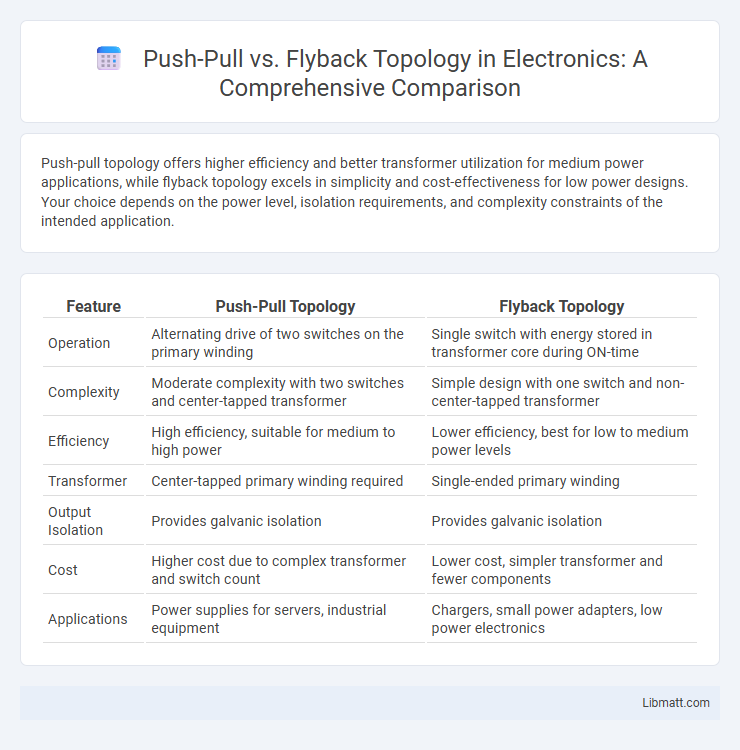Push-pull topology offers higher efficiency and better transformer utilization for medium power applications, while flyback topology excels in simplicity and cost-effectiveness for low power designs. Your choice depends on the power level, isolation requirements, and complexity constraints of the intended application.
Table of Comparison
| Feature | Push-Pull Topology | Flyback Topology |
|---|---|---|
| Operation | Alternating drive of two switches on the primary winding | Single switch with energy stored in transformer core during ON-time |
| Complexity | Moderate complexity with two switches and center-tapped transformer | Simple design with one switch and non-center-tapped transformer |
| Efficiency | High efficiency, suitable for medium to high power | Lower efficiency, best for low to medium power levels |
| Transformer | Center-tapped primary winding required | Single-ended primary winding |
| Output Isolation | Provides galvanic isolation | Provides galvanic isolation |
| Cost | Higher cost due to complex transformer and switch count | Lower cost, simpler transformer and fewer components |
| Applications | Power supplies for servers, industrial equipment | Chargers, small power adapters, low power electronics |
Introduction to DC-DC Converter Topologies
Push-pull and flyback topologies are common DC-DC converter designs used to efficiently transform voltage levels in power electronics. Push-pull converters utilize two switches alternately to drive the transformer, providing balanced magnetic flux and higher power output with improved efficiency. Flyback converters store energy in the transformer's magnetic field during the switch-on period and release it to the output during switch-off, offering a simpler design ideal for low to medium power applications and galvanic isolation.
Overview of Push-Pull Topology
Push-Pull topology uses two transistors that alternately switch to drive the transformer, offering efficient power conversion and reduced core saturation. This design enhances transformer utilization by applying voltage in both directions, resulting in improved output power density. Push-Pull converters are widely used in medium to high power applications due to their simplicity and ability to handle higher power levels compared to single-ended topologies.
Overview of Flyback Topology
Flyback topology is a popular DC-DC converter design widely used in low to medium power applications, offering isolated output voltages through a single magnetic component. It operates by storing energy in the transformer's magnetic field during the switch-on phase and releasing it during the switch-off phase, enabling efficient energy transfer. Your power supply design benefits from its simplicity, cost-effectiveness, and inherent voltage regulation capabilities, making it ideal for adapters, chargers, and standby power supplies.
Push-Pull vs Flyback: Circuit Operation
Push-pull topology operates by alternately driving two transistors to create a symmetrical voltage waveform, enhancing efficiency and reducing transformer size through balanced magnetic flux. Flyback topology stores energy in the transformer's magnetic field during the transistor's on-time and releases it to the output during the off-time, simplifying isolation and supporting multiple output voltages. Understanding these circuit operations helps you select the best topology for your power supply design based on efficiency, complexity, and load requirements.
Efficiency Comparison: Push-Pull vs Flyback
Push-pull topology offers higher efficiency than flyback converters due to its ability to utilize both halves of the transformer core, reducing core losses and enabling better magnetic utilization. Flyback converters typically exhibit lower efficiency because of higher switching losses and increased stress on components caused by energy storage and release in the transformer. Overall, push-pull designs are preferred in medium to high power applications where efficiency and thermal performance are critical.
Power Handling Capabilities
Push-Pull topology offers higher power handling capabilities compared to Flyback converters, making it suitable for medium to high-power applications typically ranging from 50 watts up to several hundred watts. Flyback topology is more commonly used in low to moderate power levels, typically below 100 watts, due to its simpler design and isolation properties. The efficiency of Push-Pull converters at higher power levels surpasses Flyback designs as it reduces core saturation and voltage stress on switches.
Component Count and Cost Analysis
Push-pull topology requires more components, including two transistors and a center-tapped transformer, increasing overall system cost and complexity compared to the flyback topology. Flyback topology uses fewer components, primarily one transistor and a simple transformer, resulting in lower manufacturing costs and simpler design. The reduced component count in flyback circuits makes them more cost-effective for low to medium power applications, whereas push-pull designs are preferred in higher power applications despite higher costs.
Isolation and Safety Considerations
Push-Pull topology offers limited isolation since it typically relies on a center-tapped transformer, which can create potential safety hazards if insulation fails. Flyback topology provides superior isolation due to its transformer design that inherently separates input and output grounds, enhancing safety in high-voltage applications. When designing your power supply, leveraging flyback's enhanced isolation ensures better protection against electric shock and meets stringent safety standards.
Common Applications for Each Topology
Push-pull topology is widely used in high-power applications such as DC-DC converters, audio amplifiers, and motor drives due to its efficiency and ability to handle higher power levels. Flyback topology is commonly found in low to medium power applications like power supplies for TVs, chargers, and isolated power circuits owing to its simplicity and cost-effectiveness. Your choice depends on the specific power requirements and isolation needs of your project.
Summary: Choosing the Right Topology
Push-pull topology offers high efficiency and good power handling for medium to high power applications, making it ideal when Your design requires balanced output and better transformer utilization. Flyback topology excels in low to medium power scenarios with simplicity and cost-effectiveness, especially suitable for isolated power supplies with multiple outputs. Selecting the right topology depends on Your power level, complexity tolerance, and efficiency requirements to optimize performance and cost.
Push-Pull vs Flyback Topology Infographic

 libmatt.com
libmatt.com